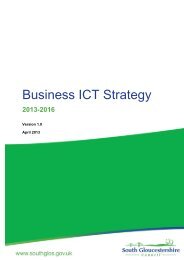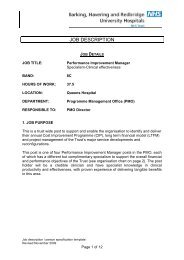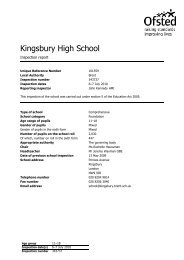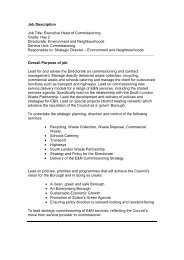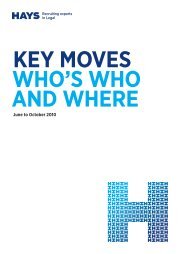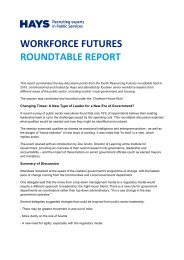RESOURCING AND TALENT PLANNING - Hays
RESOURCING AND TALENT PLANNING - Hays
RESOURCING AND TALENT PLANNING - Hays
Create successful ePaper yourself
Turn your PDF publications into a flip-book with our unique Google optimized e-Paper software.
2012<br />
growing understanding of the potential benefits<br />
of employing such people (reflecting the local<br />
community, lower turnover rate from people who<br />
don’t want to be unemployed again) and the need<br />
to tap all potential markets for required skills.<br />
Similarly, there has been an increase in the<br />
proportion of organisations who are actively<br />
trying to attract talent of all ages (59% up<br />
from 45% last year). The messages of anti-age<br />
discrimination policies may be gaining momentum<br />
as changing demographics and skill shortages<br />
increased the need for organisations to welcome<br />
talent of all ages and varieties.<br />
Traditionally we’ve found that the public sector tends<br />
to lead the way in terms of diversity. Not only are<br />
they more likely to have a formal diversity policy but<br />
previous findings have consistently found that they<br />
are more likely to use a range of methods to address<br />
diversity, when compared with organisations from<br />
other sectors that also have a formal policy. This year,<br />
while formal diversity policies remain most common<br />
in the public sector, there has been an increase in<br />
the adoption of various methods to address diversity<br />
issues in not-for-profit organisations that have a<br />
diversity policy. Not-for-profit organisations (with<br />
a formal diversity policy) have now joined the<br />
public sector in being significantly more likely<br />
than their private sector counterparts to address<br />
diversity issues through monitoring recruitment<br />
and/or staffing information; training interviewers<br />
to understand diversity; providing recruitment<br />
documents in other formats; advertising vacancies<br />
in different sources to attract under-represented<br />
groups; and through making attempts to employ<br />
the long-term unemployed (Table 19). 17<br />
Table 19: Methods used to address diversity issues in organisations (% with formal diversity strategy)<br />
Monitoring recruitment and/or staffing<br />
information to obtain data on gender,<br />
ethnicity, disability, age, and so on<br />
Training interviewers to understand<br />
what diversity is about and the impact<br />
of stereotypes<br />
2012 2011 2010 2009 2008<br />
Private<br />
sector<br />
2012<br />
Public<br />
sector<br />
2012<br />
Not-forprofit<br />
2012<br />
83 78 79 84 83 74 94 90<br />
67 57 68 68 60 58 78 81<br />
Actively trying to attract talent of all ages* 59 45 – – – 62 52 60<br />
Making attempts to employ the longterm<br />
unemployed*<br />
Operating policies that go beyond basic<br />
legislative requirements on age, gender,<br />
race, disability, sexual orientation,<br />
religion and belief<br />
Advertising vacancies in different sources<br />
to attract under-represented groups<br />
Providing recruitment documents in<br />
other formats (online, large-print, audio,<br />
and so on)<br />
Checking that any tests used are valid,<br />
reliable and culture-free and were tested<br />
on diverse norm groups<br />
Using specific images/words in your<br />
recruitment advertising to appeal to a<br />
wider audience<br />
Setting recruitment targets to correct a<br />
workforce imbalance<br />
Base: 281 (2012); 312 (2011); 253 (2010); 419 (2009)<br />
*new item added in 2011<br />
52 19 – – – 43 64 60<br />
47 39 49 52 48 42 55 50<br />
41 31 37 51 48 31 49 60<br />
39 39 41 37 31 22 63 55<br />
37 36 42 47 34 33 46 38<br />
33 29 38 42 42 28 41 38<br />
12 9 15 14 12 18 14 17<br />
<strong>RESOURCING</strong> <strong>AND</strong> <strong>TALENT</strong> <strong>PLANNING</strong> 2012<br />
27




